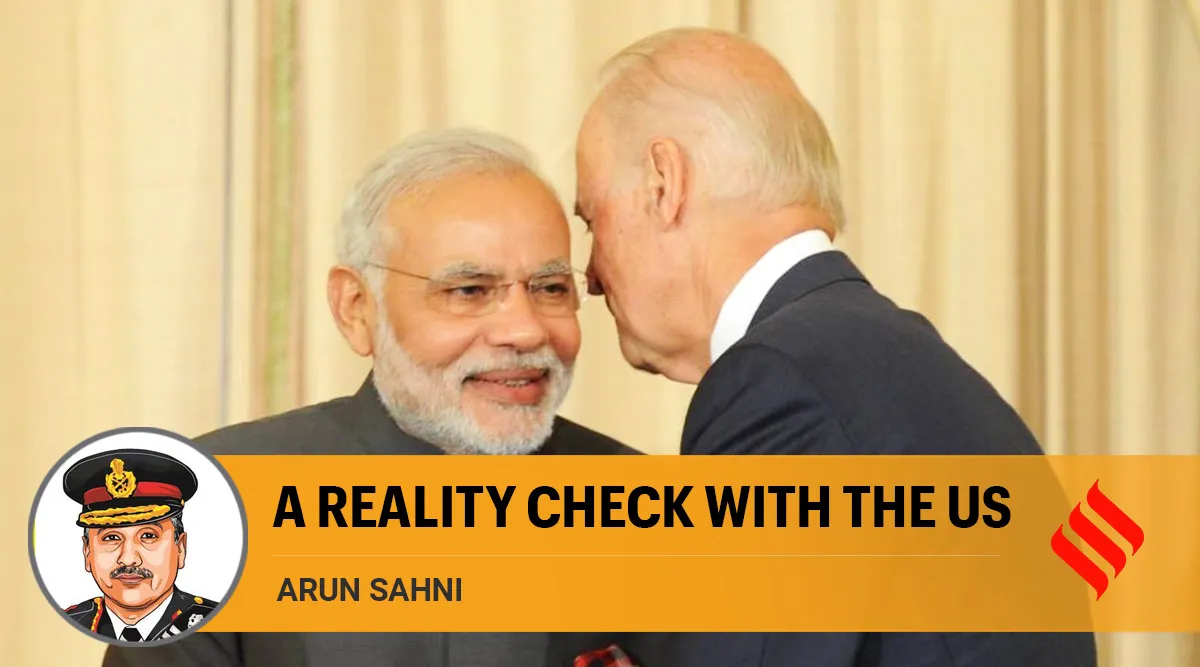Mutual interest has led to a positive new chapter in Indo-US relationship. India must prioritise its own interests and not become dependent.
Events in the recent past with respect to Indo-US relations in the Joe Biden era are contrary to the national narrative playing out in the public domain — that bilateral relations are at an all-time high. Post the euphoric Trump-Modi relationship, the officialdom has gone overboard, including by trying to move the Indian mind space towards the advantages of a closer relationship with the US. They seem to have forgotten the “trust deficit” that had earlier impeded a closer relationship between the two like-minded democracies. This was exacerbated by the US’s continued support of Pakistan despite its despicable proxy war with India and meddling in Afghanistan. India, therefore, needs to be astute and cautious, especially as suspicion has now been precipitated due to the prolonged period it took for Washington to overcome its hesitancy and permit the export of key ingredients for the manufacturing of the urgently required COVID vaccine. This was not a stray event, but the proverbial last straw on the camel’s back.
On April 7, USS John Paul Jones (DDG 53) transgressed India’s Exclusive Economic Zone (EEZ), with utter disregard of the Indian policy requiring prior intimation. The tenor of the US press release was arrogant, as it stated that the FONOP (Freedom of Navigation Operation) was consistent with international law, of which it is not a signatory. Earlier, a US Human Rights watchdog, Freedom House, downgraded India’s status from “Free” to “Partly Free”, attributing it to India’s current policies. Washington has been reluctant to include India in the Afghanistan negotiations and has not been forthcoming about waiving the provisions of CAATSA (Countering America Adversaries Through Sanction Act) to accommodate India’s past contractual obligations. This insensitivity creates doubts about the US’s unconditional support to India when the chips are down. Will it play hardball in supporting India in a manner similar to the response of the erstwhile Soviet Union in 1971? That was a different era and India is no longer in that state of helplessness. But the US leadership needs to nurture trust through its actions.
Geostrategic realities have brought the Indo-Pacific region centre stage. The shifting of the economic centre of gravity from the Atlantic to Asia has reinforced the importance of geo-economics in a connected and globalised world. China’s geographical location, its extensive economic bandwidth and ruthless pursuit for preeminence will inevitably cause turbulence. The perception is reinforced by its hegemonistic actions in the SCS, Taiwan straits, Hong Kong, Himalayas and Xinjiang. Russia’s diminishing stature and the rise of China will reflect in the future world order, but after an extended period of strife with the US. The pandemic has not only increased the pace of change but also confirmed that it is irreversible.
It is imperative that India take appropriate action to safeguard its future interests and so, has willingly partnered with the US to form a collaborative grouping of like-minded countries. The Quad, proposed a few years ago, has slowly but surely gained acceptance. Its role, shape and size are a subject of a separate debate But its relevance is non-debatable in ensuring freedom of navigation and a rules-based order. Concurrently, urgent structural reforms are required in international multilateral institutions to address the aspirations of the majority from Asia and Africa, instead of only pandering to the whims of the developed world or being a puppet of China. India will require US support to become a part of these rule-making institutions.
It was, therefore, mutual interest that led to the positive trajectory in this new chapter of India-US relations. The US, to counter intensifying strategic competition with China, needed a partner in the region and India was the logical choice. For Delhi, closer relations with Washington served its interests. But romanticising our growing proximity with the US as the balm for all our ills is where there is a need for greater attention. We cannot be lulled into complacency.
The progression of bilateral ties highlights that in the medium term, most of the actions have been to the advantage of the US. It took the initiative in starting the 2+2 dialogue between the ministers of defence and external affairs. This has over time resulted in India signing three foundational agreements — LEMOA (Logistic Exchange Memorandum of Agreement) in 2016, COMCASA (Communications Compatibility and Security Agreement) in 2018 and BECA (Basic Exchange and Cooperation Agreement) in 2020. These provide US troops access to Indian facilities and have facilitated military sales to India. It is revealing that US military sales have in the last decade grown from being negligible to $20 billion. The US has displaced Russia as being the largest source of arms imports. CAATSA, the self-serving US Act, now impinges on India’s strategic autonomy to exercise choice in conducting trade /purchase, thus straining our time-tested relationships with Russia and Iran. There is now the lure for India to be part of the “Five Eyes” network on intelligence sharing. It all looks very promising, but will India be included as an equal member in the club?
Historical experiences are illuminating: Over-dependence on the US will always have the downside of being left in the lurch when its interests have been served. Therefore, pragmatism demands that we give primacy to our national interests in this evolving relationship, and not burn our bridges elsewhere.
This column first appeared in the print edition on April 29, 2021 under the title ‘A reality check with the US’. The writer is a former army commander of the Indian Army.
Source: Read Full Article


